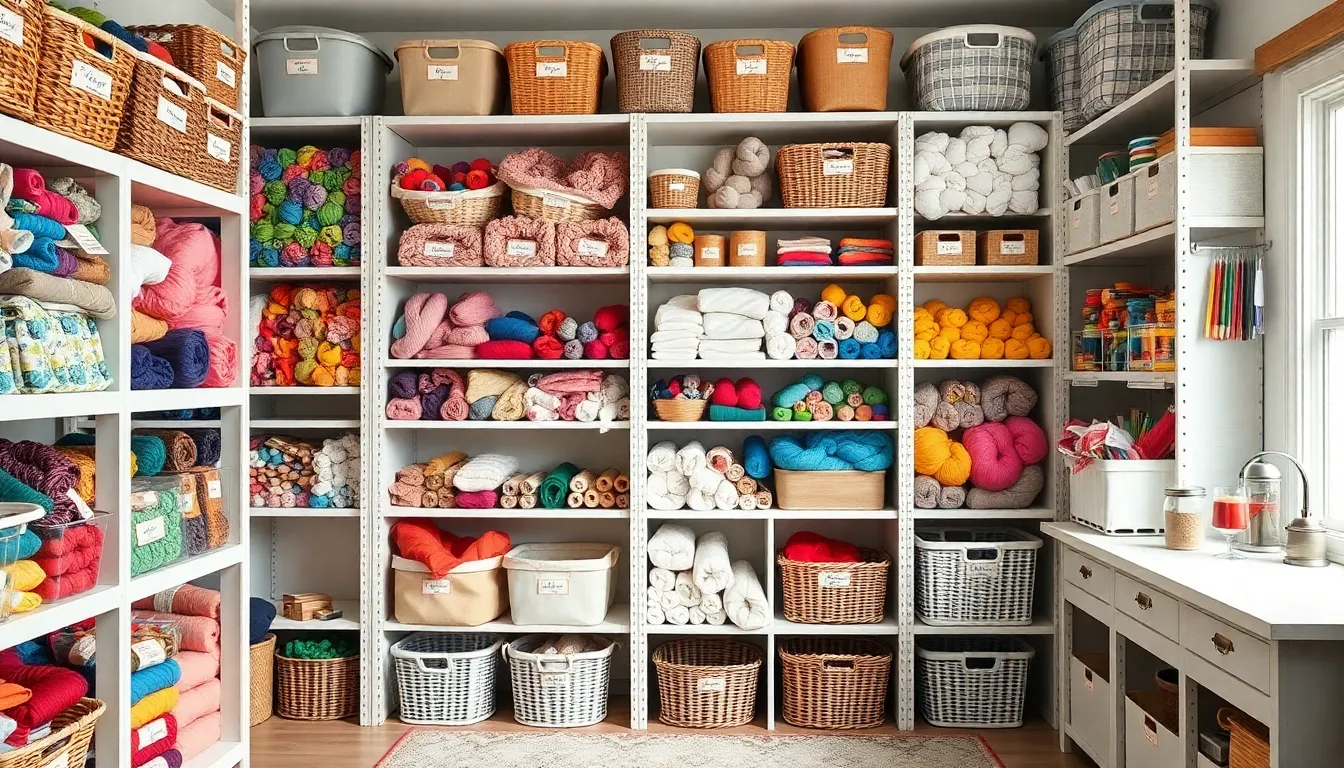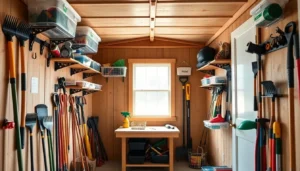Table of Contents
ToggleCrafting can spark joy, but a cluttered craft room can quickly turn that joy into chaos. If you’ve ever spent more time searching for your glue gun than actually using it, you know the struggle is real. Fear not! With a little creativity and some clever organizing ideas, you can transform your craft space from a disaster zone into a haven of inspiration.
Craft Room Organizing Ideas
Creating an efficient craft room involves innovative storage solutions that enhance accessibility. Utilize shelving units to organize supplies, ensuring each item has a designated space. Install wall-mounted organizers for easy access to frequently used tools. Clear plastic bins facilitate visibility while protecting materials from dust and damage.
Designate specific zones for crafting activities, using tables for cutting and assembling projects. Ensure every zone remains clutter-free by regularly assessing what’s essential. Incorporate a rolling cart to store smaller items, allowing for easy mobility and adaptability during crafting sessions.
Consider using pegboards for tools; they maximize vertical space and keep items within reach. Label each storage container with clear identifiers, streamlining the process of finding materials. Include baskets for yarn and fabric, sorting by color or type to simplify selections.
Incorporate a bulletin board to showcase ideas and inspiration. It helps maintain focus and motivates creativity by surrounding crafters with visual stimulation. Establish a routine for cleaning and reorganizing; it ensures the craft room remains a sanctuary for creating rather than a source of stress.
Explore multi-functional furniture, such as tables that fold down when not in use. Using space efficiently promotes a more enjoyable crafting experience. By implementing these ideas, a well-organized craft room becomes attainable, transforming chaos into creativity.
Essential Storage Solutions

Creating an organized craft room requires efficient storage solutions. Cleverly designed systems help maximize space and improve accessibility.
Shelving Units
Shelving units play a critical role in any craft room. Open shelves allow easy access to supplies while enabling visibility. Customizable units can fit various spaces and styles, adapting to the specific needs of the crafter. Consider adding adjustable shelves to accommodate larger materials. Implementing labeled bins on shelves further enhances organization by categorizing frequently used items. Sturdy materials ensure longevity, making shelving units a wise investment for any crafting space.
Bins and Baskets
Bins and baskets are essential for maintaining order. Clear plastic bins provide visibility, helping locate items quickly. Baskets, with their aesthetic appeal, can stylishly hold yarn, fabric, or miscellaneous supplies. Various sizes accommodate different materials, making sorting easy. Labeling these containers enhances efficiency, simplifying the selection process during crafting. Group similar items in assigned locations to streamline workflows, ensuring a tidy environment conducive to creativity.
Creative Workspaces
Creating a functional craft room involves maximizing space and organization. A few well-planned elements can transform the workspace into a creative haven.
Desk Organization
Focused desk organization enhances productivity. Keep essentials within arm’s reach by using desk organizers for tools. Consider using tiered trays or small containers for easy access to frequently used items. Positioning a magnetic strip along the edge of the desk securely holds metal tools. Utilize drawer dividers for separating supplies, ensuring that everything has a designated spot. By decluttering the surface, inspiration flows freely, contributing to a more enjoyable crafting experience.
Craft Carts
Incorporating craft carts adds versatility to any workspace. Utilize rolling carts to store various supplies, allowing easy mobility when working on different projects. Assign specific carts for items like paint, fabric, or paper, creating dedicated zones. Craft carts with multiple tiers maximize vertical space, accommodating an array of materials. Select a cart with clear bins for visibility, enabling quick access to contents. By organizing supplies in this manner, crafters maintain a streamlined space, paving the way for creativity.
Labeling Techniques
Effective labeling elevates organization, making it easy to locate supplies. Implementation of a consistent labeling system enhances efficiency.
Labeling Systems
Establishing a labeling system requires clarity and consistency. Use waterproof labels for areas exposed to moisture, like paint containers. Consider integrating both written and printed labels that display item names for quick identification. Additional category indicators, such as “paper,” “glue,” or “tools,” simplify access to frequently used materials. Labeling containers allows for a smooth workflow, while stackable bins featuring labeled fronts enable easy viewing. Don’t forget to regularly update labels as inventory changes, ensuring the system remains relevant.
Color Coding
Color coding adds an extra layer of organization. Assign specific colors to different categories, like blue for fabrics and green for paper supplies. Utilize colored labels or tape to distinguish items quickly. Visual organization enhances creativity since vibrant colors can inspire creativity. Incorporating color-coded bins allows for easy grouping and identification of similar items. Maintain consistency in color usage throughout the craft room for clarity, creating a visually appealing and manageable space.
Maintaining an Organized Space
Establishing a cleaning routine for a craft room helps keep it organized. Setting aside time once a week for tidying up ensures clutter doesn’t accumulate. Dedication to maintaining cleanliness reflects a commitment to crafting success.
Utilizing organizational tools is vital for long-term order. Shelving units cater to various supplies, providing easy access while maximizing space. Containers enhance organization, especially when grouped by project or material type.
Labeling storage is essential for quick identification. A consistent system of labels allows for easy navigation and selection of items. Incorporating waterproof labels can protect against moisture in areas exposed to water.
Creating designated zones for specific crafts reduces confusion. Space division based on activities can streamline processes, allowing for a more focused and enjoyable crafting experience. Crafting carts encourage portability, enabling movement between different crafting areas and lending flexibility.
Adjusting storage solutions as crafting habits change is beneficial. Seasonal projects may introduce new materials, so updating storage methods can keep the craft room functional. Regularly reviewing storage needs can promote a seamless crafting environment.
Implementing color coding enhances visual organization. Assigning specific colors to categories like fabric, paper, or yarn simplifies finding supplies. Easy grouping improves accessibility and encourages enthusiasm towards creative projects.
Encouraging creativity through organization establishes a happier crafting experience. Maintaining an organized space relieves stress and promotes productivity. This commitment to ongoing organization transforms a craft room into a true creative haven.
An organized craft room can significantly enhance the crafting experience. By implementing smart storage solutions and maintaining a routine, crafters can create a space that inspires creativity. Utilizing shelving units, clear bins, and labeled containers not only keeps supplies accessible but also fosters a sense of order.
Incorporating designated zones for different activities ensures that everything has its place, reducing frustration and maximizing efficiency. With these strategies in place, crafters can transform their workspaces into inviting environments that encourage exploration and innovation. A well-organized craft room is more than just a tidy space; it’s a foundation for creativity and joy in every project.




